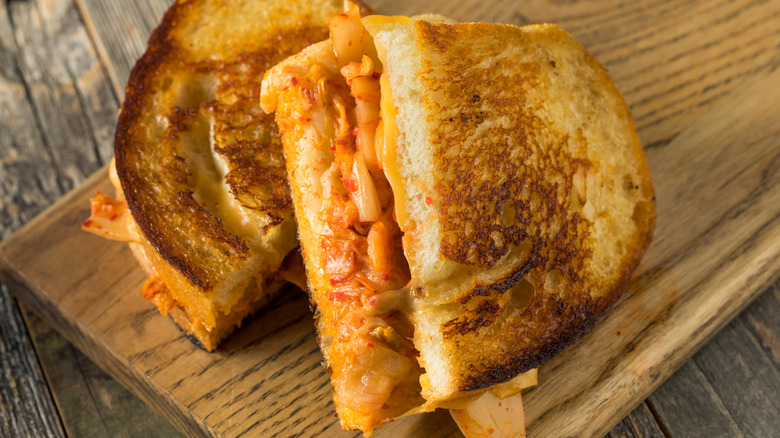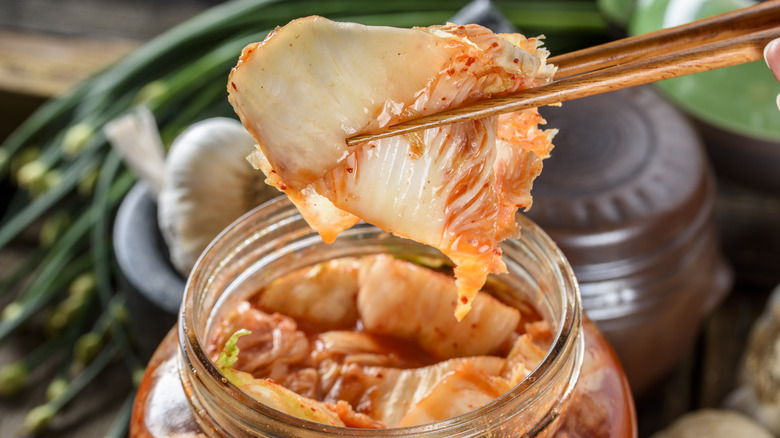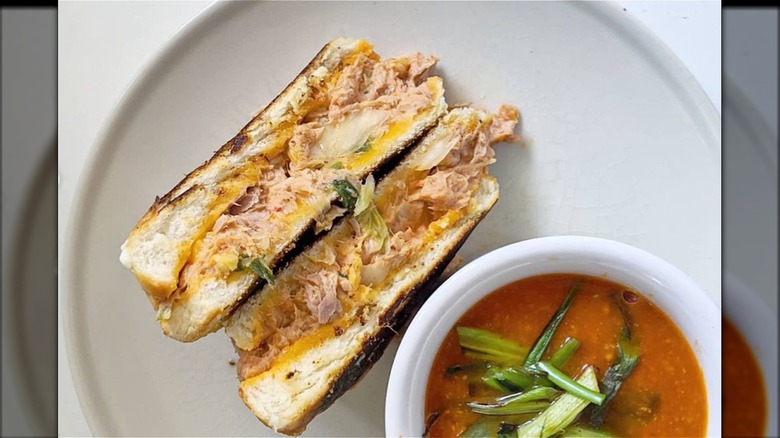Elevate Your Tuna Melt With The Spicy Goodness Of Kimchi
Approximately 4000 years ago, the gift of kimchi was born into the culinary world. Its ancient history makes a captivating tale, but its future is as intriguing. This ingredient is commonly mixed, garnished, boiled, or incorporated into Korean cuisine, exquisitely adding spice, crunch, and the glorious taste of umami. While canned tuna and kimchi are an iconic pairing in traditional Korean cooking, there are innovative ways these ingredients have captured people's attention. We're talking about the kimchi tuna melt.
Think about it this way: A solid tuna salad is nothing without some tangy fermented ingredient, such as pickles. Kimchi is an extension of this concept. Picture your favorite tuna salad with a spicy crunch, gooey melted cheddar, and two crusty pieces of bread. It's utter comfort sandwich perfection.
No prior preparation is required, as kimchi can be easily layered on one piece of bread before the tuna salad is lovingly smothered over the top. Of course, if you plan to use chunky tuna pieces, you may wish to finely chop the kimchi to lend a more dynamic texture contrast. Becoming familiar with canned tuna varieties can be exceptionally useful, especially in this circumstance. Let the kimchi tuna melt dreams begin.
Choose wisely when picking kimchi for your tuna melt
Kimchi flavors are as versatile as the colors in a rainbow, and it would be a disservice to this delicious ingredient not to detail its various forms. The most apparent contrast lies in color, with red kimchi indicating the inclusion of gochugaru or Korean chili flakes, which signify spiciness. White kimchi, also named baek kimchi, has a milder temperament and refreshing zing. Regarding your tuna melt, choose a spice level you will enjoy while recognizing that the cheese will slightly subdue some of the heat.
Different vegetables can fall under the kimchi label and will add different textures to your tuna melt. The most likely variety you are familiar with is baechu kimchi, made with napa cabbage. When fermented, this vegetable has a beautiful tender crunch similar to pickles. Kkakdugi kimchi is made from cubed radish, while oi sobagi, which translates to stuffed cucumber, is a cucumber kimchi variety. These latter two are traditionally served in soups and stews, perhaps due to their super juicy consistency.
When selecting a type of kimchi, it's best to question how suited they would be to a tuna melt since high moisture content vegetables may upset the crunchiness of the bread. In other words, who wants a soggy tuna melt?
Complimentary additions to a kimchi tuna melt
After you've chosen your tuna, kimchi, bread, and cheese, there are countless other additions to this powerhouse sandwich to consider. Instead of mixing ordinary mayonnaise into canned tuna, try switching it up with Sriracha mayo. Against the cooling backdrop of the mayonnaise, the spicy, sweet, and tangy elements in the Sriracha highlight similar flavors in the kimchi. It's an umami dreamboat.
If you prefer the seriously spicy side of life, you may even go as far as to mix a few dollops of gochujang into your tuna mixture before layering up the melt inside the bread. Gochujang's spiciness can vary like kimchi, but it is usually used to add a fiery edge and umami punch.
While kimchi can be added cold in the tuna melt before being grilled, it can also be fried beforehand. If you decide to go down this avenue, consider frying the kimchi in sesame oil to add some nutty, earthy undertones — and another level of flavor complexity to your tuna melt. Kimchi tuna melts are the next trend in spicy sandwiches. Fishy, fiery, and cheesy, this grilled sandwich combination is one you don't want to miss out on trying.


